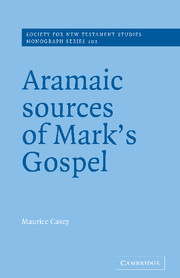Book contents
- Frontmatter
- Contents
- Preface
- List of abbreviations
- 1 The state of play
- 2 Method
- 3 Jesus' scriptural understanding of John the Baptist's death: Mark 9.11–13
- 4 Two sabbath controversies: Mark 2.23–3.6
- 5 The question of Jacob and John: Mark 10.35–45
- 6 Jesus' final Passover with his disciples: Mark 14.12–26
- 7 Conclusions
- Select bibliography
- Index of passages discussed
- Index of names and subjects
7 - Conclusions
Published online by Cambridge University Press: 22 September 2009
- Frontmatter
- Contents
- Preface
- List of abbreviations
- 1 The state of play
- 2 Method
- 3 Jesus' scriptural understanding of John the Baptist's death: Mark 9.11–13
- 4 Two sabbath controversies: Mark 2.23–3.6
- 5 The question of Jacob and John: Mark 10.35–45
- 6 Jesus' final Passover with his disciples: Mark 14.12–26
- 7 Conclusions
- Select bibliography
- Index of passages discussed
- Index of names and subjects
Summary
We saw in ch. 1 that the quest of the historical Jesus has made little use of Aramaic as an investigative tool. This is a remarkable fact. Most people have noticed that language is a significant part of culture, but the study of Jesus has proceeded as if this were not the case. It has been largely a Christian enterprise, and the sacred text is in Greek. Too much reconstruction of a Jewish man is liable to create problems for the doctrine of the Trinity. Hence a few specialised people have done all the existing work. Only two outstanding books have been written, those of Meyer and Black, in 1896 and 1946, before the discovery of the Dead Sea scrolls. As we consider the history of scholarship so long afterwards, no praise can be too high for these two brilliant and independent men.
The discovery of the scrolls puts us in a position to alter the nature of this work. Throughout the first century of critical scholarship, the use of Aramaic was beset with such severe problems that most scholars might well feel that it was a specialised area of dubious value. We saw this especially in considering the work of scholars such as Torrey and Burney, most of whose suggestions could not be accepted.
- Type
- Chapter
- Information
- Aramaic Sources of Mark's Gospel , pp. 253 - 260Publisher: Cambridge University PressPrint publication year: 1999

